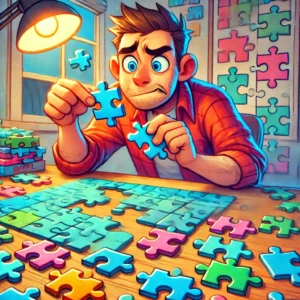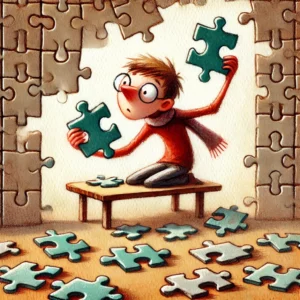
False Fit or False Edge? Jigsaw puzzles are a great way to challenge the mind, relax, and have fun. But there’s nothing more frustrating than thinking you’ve found the perfect piece – only to realize later that it doesn’t actually belong in that spot. This is what’s known as a false fit in the world of puzzling. And a False Edge is, you guessed it, a jigsaw puzzle false fit edge piece.
False Fits is a Jigsaw Puzzle Enthusiasts Nightmare
False fits can throw off your entire solving process, leading to confusion and frustration. False edges are almost worse because so many people start their jigsaw puzzles with the edge pieces as this is a practical way to start your jigsaw. Why do they happen, and how can you avoid them? Let’s dive into the causes of false fits and how to ensure you’re placing the right piece in the right spot.
Table of Contents
What is a False Fit in a Jigsaw Puzzle?
A false fit occurs when a jigsaw puzzle piece appears to connect correctly to another piece or section of the puzzle but actually belongs elsewhere. Yes, this is something puzzle enthusiasts mumble about and rightfully so. This often leads to mistakes in assembling the puzzle, causing pieces to not align properly, gaps in the completed image, or a section that just doesn’t feel quite right.
Sometimes, a false fit is immediately obvious. The image doesn’t line up and visually the player knows it’s wrong. Yet, in trickier cases, the mistake might not become clear until several pieces later, forcing you to backtrack and rework entire sections. This can be a serious situation when you are speed puzzling or wanting to relax only to find out all the world you put into the puzzles has been triggered by a false fit.
Why Do False Fits Happen?
False fits can occur for several reasons, ranging from jigsaw puzzle design choices to human perception errors. Here are the most common causes of false fits:
1. Repetitive or Similar Shapes
Some jigsaw puzzles use a grid-cut pattern where many pieces have the same basic shape, such as two “out” tabs and two “in” slots. If the puzzle doesn’t have much variation in shape, it increases the likelihood of false fits because multiple pieces could physically connect i even if they don’t belong together.
2. Color and Pattern Similarities
Another major factor is the puzzle’s artwork. If the puzzle features large areas of similar colors – such as a blue sky, grassy field, or ocean waves – it can be easy to place pieces incorrectly based on color alone. Your brain assumes that because the color and pattern match, the fit must be correct, even if the shape isn’t perfect.
3. Poorly Cut Puzzles
Some puzzles are mass-produced with less precision in their cutting process, which can lead to pieces that are too similar in shape or slightly misaligned. In cheaper or lower-quality puzzles, you may notice that some pieces seem to “fit” in multiple places when they shouldn’t.
4. Warped or Bent Pieces
A puzzle that has been exposed to humidity, moisture, or rough handling may develop bent or warped pieces. This can alter their shape just enough that they incorrectly fit into spaces where they normally wouldn’t, creating false fits.
5. The Puzzler’s Perception and Confirmation Bias
Sometimes, false fits happen because we want a piece to fit. If you’ve been searching for a particular piece for a long time, you might convince yourself that a near-fit is actually correct, especially if you’re tired or working under poor lighting conditions. Your brain seeks patterns, and in some cases, it might trick you into seeing a match that isn’t there.
How to Avoid False Fits in Jigsaw Puzzles
1. Look for Unique Cuts
When buying a puzzle, opt for brands that use random-cut pieces rather than traditional grid-cut designs. Random-cut puzzles feature irregular, distinct shapes that make it harder to place pieces incorrectly.
2. Double-Check the Image Alignment
Before pressing a piece into place, always verify that the printed image lines up seamlessly. Even if the shape seems to fit, an off-kilter line or mismatched pattern is a clear sign of a false fit.
3. Work on Small, Distinct Sections First
Start by assembling easy-to-recognize sections—such as faces, lettering, or uniquely colored objects—before moving on to larger, repetitive areas like skies or water. This reduces the risk of false fits in tricky sections.
4. Use the “Lift and Rotate” Test
Once you’ve placed a piece, gently lift it and rotate it slightly. A true fit should lock in smoothly and feel secure, while a false fit might shift, wiggle, or feel loose.
5. Step Away and Take Breaks

If you’ve been working on a puzzle for a long stretch and suddenly start making mistakes, it might be time for a break. Taking a moment away from the puzzle allows your brain to reset, making it easier to spot false fits when you return.
6. Store Your Puzzle Properly
To prevent bent or warped pieces, store your puzzles in a dry area, away from humidity or extreme temperature changes. If a piece is slightly warped, try placing it under a heavy book for a few hours to flatten it back out.
Don’t Be Frustrated…It Doesn’t Happen Often
False fits are one of the most frustrating parts of solving jigsaw puzzles, but they can be avoided with the right strategies. By being mindful of shape variations, image alignment, and puzzle quality, you can minimize errors and enjoy a smoother, more satisfying puzzle-solving experience.
Next time you’re working on a jigsaw puzzle and something feels “off,” take a step back and double-check your connections—you might just have a sneaky false fit on your hands! Happy puzzling!
